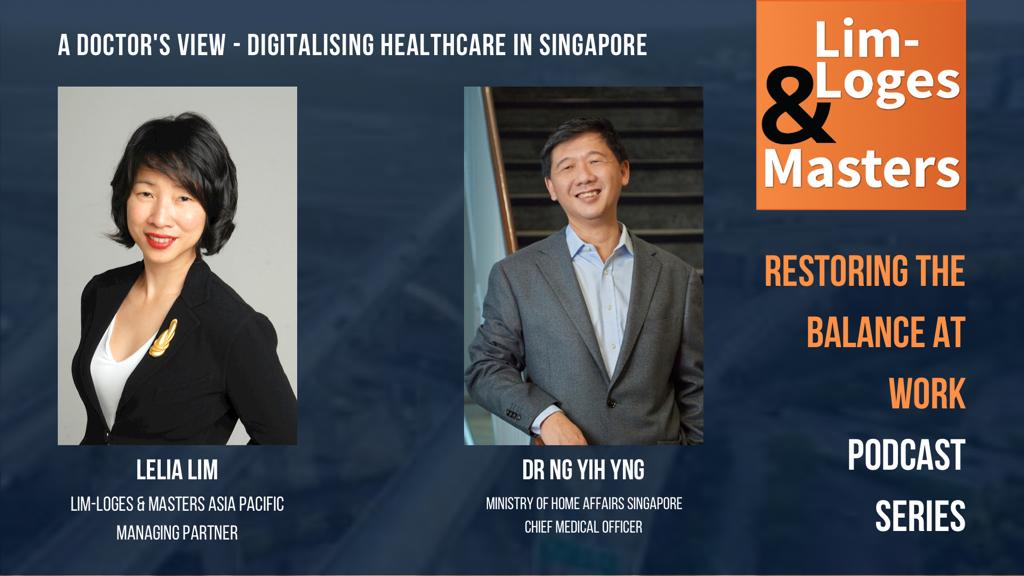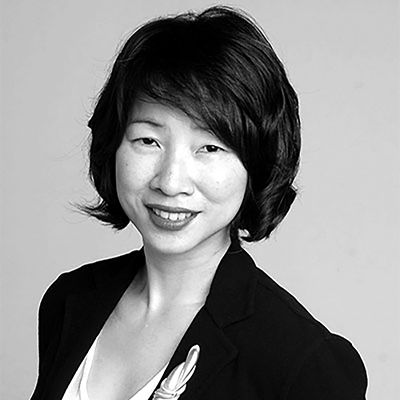

Lelia Lim
“Restoring the Balance at Work” Podcast series-Episode 3: ‘A Doctor’s view – Digitalising Healthcare in Singapore’
Episode 3: ‘A Doctor’s view – Digitalising Healthcare in Singapore’ featuring special guest Dr Ng Yih Yng, Director of the Digital & Smart Health Office, Tan Tock Seng hospital; Deputy Clinical Director, Ng Teng Fong Centre for Health Innovation; Chief Medical Officer with the Ministry of Home Affairs, Singapore
(To watch and listen to the full podcast, click here: )
Welcome to Lim-Loges & Masters “Restoring the Balance at Work” podcast series looking at the challenges businesses face today and their impact on a disrupted economy. Lim-Loges & Masters is a leading HR consultancy in Asia Pacific that helps organisations transform through their people through three distinct yet connected services, Disruption Management, Executive Search and Transition Management. Today’s podcast is about ESG, rebuilding the employee landscape, people profit planets, and we are joined in the studio by founder and Managing Partner Lelia Lim. Lelia has 30 years of experience in the natural resources industry and executive search. Previously at Korn Ferry International for close to 13 years. Lelia, welcome!
Lelia Lim:
Welcome everybody. It’s so good to be back again. And in the COVID era, we are seeing some signs of return to normalcy. We have a very special guest with us today, someone who understands what it is to handle emergencies, and boy, did we need to understand emergencies when COVID-19 struck us. This podcast episode looks at how digital technologies can drive transformation in the healthcare industry. It discusses the challenges and opportunities that exist and provides examples of how healthcare providers have succeeded in using digitalisation to improve healthcare delivery. And we will also talk about what’s to come.
According to McKinsey, digital health today impacts more than a billion lives. And estimates show that digital health in Asia could collectively create up to $100 billion in value by 2025, up from $37 billion in 2020.
Now we have with us, Dr Ng Yih Yng, who is an extremely busy man, and we are privileged to have him in our podcast series on restoring the balance this 2022. Today, Dr Ng is busy in four roles. He is the Director of the Digital & Smart Health Office for Tan Tock Seng hospital, as well as the Central Health region in Singapore. He is the Deputy Clinical Director of the Ng Teng Fong Centre for Health Innovation. And concurrently, he serves as the Chief Medical Officer with the Ministry of Home Affairs, Singapore, and oversees the healthcare policies across the HomeTeam Departments. He is trained as an emergency and public health specialist, and practices emergency medicine at Tan Tock Seng Hospital Emergency Department. He’s a prolific publisher of scientific articles and lectures globally on Public Health, Digital Health and Emergency Medicine – when he can spare the time, and that’s very little and few and far between! He teaches and conducts research with the Lee Kong Chian NTU School of Medicine, the Duke-NUS Prehospital Emergency Research Centre, and the Saw Swee Hock School of Public Health in Singapore. So welcome, Dr Ng!
Dr Ng:
Thank you Lelia, thanks for the introduction, it is a little bit long! Yes, glad to be here.
Lelia Lim:
I know it’s good to have you here with us. And thank you for your time again.
You hold several portfolios Dr Ng, so tell us what you do, especially in leading the Digital & Smart Health Office? What is the intent of this office? And how does it make a difference?
Dr Ng:
OK, so I’ll just do a quick run-through. I work as the HomeTeam Chief Medical Officer, which is sort of a policy and regulatory role, and we take care of the health of our HomeTeam officers, which are like the police, the prisons, immigration, but the larger part of my role is actually that of the Digital & Smart Health Office. So in this aspect, we recognise that the hospital has many things going on, there are IT projects, there are efforts at digitalisation, however, there isn’t really a true focus for these things. So the idea of setting up a Digital & Smart Health Office is actually to look at all the common pains, the common challenges that everybody has, and look at how we can fundamentally simplify, streamline and improve the way we deal with all these developing digitalisation, digital transformation efforts. So in short, looking at the strategy, streamlining processes, enable the innovators to get on with the crux of the innovation, rather than to fight with a lot of issues with administration, funding issues, as well as some of the basic technology challenges that everybody has to deal with. So we want them to get on with the job while we take care of business for them.
Lelia Lim:
And how important is digitalisation in the healthcare industry in Singapore?
Dr Ng:
Oh, where do I start? I think we’ve lived through COVID. And I think we are still living through COVID, and from that perspective, we all start to recognise more closely how important good health care is, how important an excellent health care system makes in the economy of a country and our ability to be able to get ourselves through this current COVID pandemic. We know that healthcare costs are definitely rising. We know that aging population is a challenge, especially in Singapore. We seem to have a fairly low birth rate plus coupled with increasing life expectancy in Singapore. So this creates a dependency ratio where there are fewer and fewer people taking care of more and more elderly. And with a rising average lifespan of a Singaporean, the demand for health care goes up.
So, when you look at all these things rolled together, we know that the demand for healthcare services will continue to grow. And we also know that given time, technology, including health tech becomes more and more complex, more sophisticated. And we as citizens want more of it, we want to live better, we want to live longer, and we want to live well. So when we look at this, digitalisation then plays a very big part in helping us manage the increasing complexity of healthcare.
Lelia Lim:
Absolutely necessary. Has covid, and you mentioned it, has COVID accelerated your transformation initiative, or provided a different perspective for you? How has it affected dealing with any future pandemics, for example?
Dr Ng:
I think everybody, COVID is something that no one can escape from. And we’ve all had our own run-ins from getting COVID or knowing someone who’s got COVID. And even when you’re not directly affected, COVID has made its impact felt in all sectors of society, whether it is you taking public transport, your ability to go out and have lunch or dinner, your ability to meet up with friends, or even if you have elderly parents, how you take care of them at home, or if they are going to a hospital. So there isn’t a single person who can say that they are not affected by COVID in the last two years. How this has changed us fundamentally as a healthcare industry is that we have had to accelerate many of the plans that hospitals have talked about and often never had the risk perception to say that we wanted to do it. Take Telehealth, for example, there’s always this perception that Telehealth may not be as good as running healthcare services in person. So this has been that long-standing challenge that we’ve always seen Telehealth from a regulatory perspective to be maybe slightly less good. And because when we view it as a like-for-like kind of service, we are not prepared to do it in a big way. But now that when COVID hit all of a sudden, we have no choice, coming together and seeing a person face-to-face and with the risk of catching COVID, suddenly Telehealth becomes super attractive. Most of the upside without the downside of being able to transmit COVID or catching COVID from someone is a massive bonus. So suddenly, this whole risk perception shifts to the other direction. And that has helped the adoption for things like Telehealth, virtual services, even e-payment. No one wants to exchange dollar notes or or take coins anymore, because you don’t know what’s on the coin or what’s on the dollar note. And it’s not just us, you go to the Hawker centre, just about every Hawker centre selling a plate of chicken rice is prepared to use Grab Pay, PayNow, Paylah or whatever pay system there is.
Lelia Lim:
Contactless systems, I know! Amazing. Yes, the rate adoption is extremely high now across Singapore. So digital transformation, as you know is more about people, right? At the end of the day, you talk about risk, but it’s that perception of risks, which is very people-oriented. And it’s more about new ways of working than it is about the technology itself. The technology has been there, it was a question of us accepting it and using it. So it requires organisational changes that are customer-centric, backed by leadership, driven by radical challenges to corporate culture, and the leveraging of technologies that empower and enable your employees.
So why was the transformation programme that you drove absolutely necessary? Who does it impact? Tell us a bit more about the smart hospital, the smart campuses, the smart community we’re trying to create.
Dr Ng:
I think fundamentally, when you look at Singapore as a country where manpower is really a premium, we just do not have that many people in the country. If you look at when you couple this with surge of demand for healthcare services, we know, it’s always going to be difficult to be able to meet those demands. At the same time, we also recognise that there are many things that we do today that are repetitive, that are potentially replaceable, with self-service, virtual services, and many other ways of being able to meet those needs without the man in the loop. So we recognise that through digitalisation, and also health technology, there are many things that patients could really be able to manage through the use of health technology. So whether it is remote monitoring, whether it’s self-service booking, access to services, to obtain information, or make choices, for example, when is your appointment, for example, we really don’t need to wait on the wait on the phone for 15 minutes to get hold of a person, for example, just to change an appointment. So many of these things actually decompresses some of that demand. It also at the same time drives up patient satisfaction – I could do this at 2am in the morning and I don’t have to be upset that the hospital doesn’t have an operator waiting for my phone call at 2am. I can do it at any point of time somebody picks it up, changes the appointment and sends me a message saying, OK, now your new appointment is the date that you really wanted to be. I don’t care the reason what it is or why you wanted that day. But you get the date that you really wanted, because you could see what is available to you.
Lelia Lim:
Yes at the end of the day, it has to impact people in order to make a difference. And maybe you can share with us some examples out there, not just limited to Singapore but across Asia, some examples of successful digitisation in health care, that you think have been extremely effective, especially in emergency response.
Dr Ng:
I think there are definitely some things that we can share. For example, when we look at our own examples of digitalisation, for example, one of the things I did when I was in the Singapore Civil Defence Force was that we created a mobile app, it was called the My Responder mobile app. It is very simply Grab or Uber for CPR and getting an AED, which is an Automated External Defibrillator. So the idea of this was that it was like micro volunteering, you find people who are trained to do CPR, use an Automated External Defibrillator. And you let them know that if somebody called 995, about a person in cardiac arrest, if they are within a 400 metre radius and able to get there would be alerted by the 995 operations centre. And if they are free, they are available, they could run in there, maybe within about 2-4 minutes, help to render aid and continue to perform chest compressions until the SCDF comes by with a fire biker who is an EMT, an emergency medical technician, who will take over from this person, and then followed by ambulance with a paramedic, that would be able to offer advanced assistance, pre-hospital care, and then transport the patient to the hospital. So, for a person volunteering, you may be only called up maybe once or twice a year. But when you get called up and you’re able to help, you could potentially save a life. It’s not a lot of commitment, all you need to do is download an app. And at the same time, it meets a very particular and very powerful need, you see, and that saves a life.
So I think we need to find the kind of use cases that leverages on digitalisation and unlocks a certain value. And that is just one very niche kind of example, but I do believe that in healthcare, there are many other examples. To me, where I think the value would be is that mobile apps have an amazing ability to help people understand health information. That’s a fundamental gap in many Asian societies. Most of the time, looking at maybe the generation before me, my parents or the grandparents, is a generation of people who trust that the doctors know everything – the doctor tells me what I do, and then I do it. But we are starting to move to a generation where people want to be a lot more involved, they want to understand, they want to know what’s going on. And then the venues for giving them good, sound, medical information, advice that is customised to them is not always available. There’s a lot of stuff on Google, there’s really a lot of information. The problem is, it’s always hard to figure out what’s real, what is sound advice, what is relevant to their health situation. And I think that, essentially, is the challenge. So as a public health care institution, or even in our local health care system, I think our obligation is to be able to help people navigate their health, and their particular health, not just general health information, but health that is relevant to let’s say, himself, or herself or myself, for example. And that’s what we want.
Lelia Lim:
Yes. And this is a side comment, I know that insurance companies today are getting increasingly engaged with hospitals in order to provide patients with more wellness programmes, and that means being very proactive and personalised, in engaging with that customer or that particular person.
Dr Ng:
I would even argue that you need to be more hyper-personalised and hyper-engaged. What do I mean by that? Because when you look at the insurance systems module, I think they tend to, some of them, most of them scratch the surface. Some of them may be able to move towards a more personalised model, like maybe you’re a bit more sedentary, I’m offering you a gym membership. We do want to get to the point where, because as a healthcare system, we will be able to see really on a very granular basis, your health issues – hypertension, diabetes – and we can offer you information guidelines about what would be the most effective things to do. And being able to give you, empower you to know exactly what are the things that are evidenced-based, what are the things that would help keep you in good health. Or if you have chronic illness, what can keep the illness at bay, under control, so that you have the life expectancy, you have the quality of life that you desire, in the long term. So it’s not just understanding the health, but being able to navigate this health journey. Knowing the resources, knowing the correct interventions, and then being able to do these things and see, what is the impact. I mean, I want to know that let’s say if you asked me to take this medication, I can see from the follow ups and the data that you are sharing with me that this seems to be working. Then for me getting the feedback as a user or customer, it is something that is very encouraging. So I know I’m on the right path, and I should continue doing this. So this whole interactivity of data, seeing your health status, knowing the intervention, carrying it, and then after that, seeing the feedback that oh, it is working. That is reinforcing. And that is what keeps us on this healthcare journey.
Lelia Lim:
Oh, no, this is exciting. I mean, you talk about this journey, and it can be exhausting. Unless you understand what it is to measure success or realise you’ve been successful. So what have those successes meant in digitalising healthcare services in Singapore? How do you measure it? Maybe you can share your measurements of success.
Dr Ng:
I think we’re still in very early stages. And I think on the national level, you would have seen some of the initiatives being mentioned by MOH. We’re talking about capitation of health care. I think Minister Ong Ye Kung has been talking about Healthier SG. So some of these buzzwords where we talk about capitation, we talk about how do we deliver long term value that’s sustainable in health care. And MOH also has this vision. They call them the Three Beyonds. I don’t know if you’ve heard of it?
Lelia Lim:
No, please share.
Dr Ng:
OK, I’m not the originator. This is really from the Ministry of Health, but the Three Beyonds talk about moving beyond hospital to community because you don’t want people to be in hospital, we’re looking at sick care. You’re only being taken care of when you’re extremely ill. But you want to move the care to the community where people are being well managed in the community, you are at a stage where your diseases are under control. So beyond hospital, to community. And then the other one is beyond health care to health. So the model is different. You’re not looking at health care, but you’re looking at keeping people in the healthy status. So you want to go to the point where you’re more proactive and preventive. And then the last one, and this probably, to me is the most important one and this is the clincher, which is beyond quality, to value. So why that is important is that when we look at quality as a single dimension thing, quality in a way, it’s endless. We always want higher quality. But the truth is this, there is no way to have unlimited quality, you really do need to think about moving from quality to value based care, because there is dimension that money is not unlimited. Manpower is not unlimited. So how do we deliver the best care for the resources that we have? So we do need to see what is cost effective for the whole health care system. Because for every dollar I spend here, I’m not spending it there. And and we do recognise that over time, the responsibility for expenditure and the responsibility for this value, it’s not just government’s responsibility, there’s also a citizen component to it, because what we value for health, may be very different from what a doctor sees as quality.
Let me explain. So the doctor may say, based on these guidelines, this is the best quality of care, deliver X dollar, correct? But then, for you as a citizen, it may not always be what you value as an outcome. So for somebody to say, I will value, for example, if I have care for cancer, for example, and the cancer may not be treatable, the doctor may tell you that, hey, if you take all these drugs, you may be able to last for a year and a half, by going through chemo, radiotherapy, for example. But the patient may say, I may not value living for one and a half years with cancer, to me, I may want to have a good quality of life, be able to go through this without having to deal with chemotherapy, or radiotherapy. So from that perspective, the patient’s own perception of what is value for him, or what is good outcome for him may be very different. He may not want endless visits to the hospital, he may want to be in good enough health to spend the time with his family, because he knows that just more time may not always mean better quality time. So I think when I look at hyper personalisation, and hyper customisation, it really depends on what your opinion of value is, what is your perception of quality?
Lelia Lim:
Yes, it’s very subjective.
Dr Ng:
It is indeed.
Lelia Lim:
We talk about successes, let’s look a little bit at challenges. You were once quoted as saying that the raison d’etre for an idea becomes much clearer when you get questioned, laughed at and rejected enough times. What have some of the challenges of digital transformation been in the healthcare landscape and how have you overcome them?
Dr Ng:
I think that was something I said, doing some projects in the public sector. I think sometimes we do need to dare to dream, we do need to dare to be bold and ambitious. And in doing so, we often challenge the status quo. And in the process of doing that, I think there’s always going to be people who are very sceptical about whether it’s doable, because if it’s never been done before, I think sometimes as a public sector, we tend to be a little bit more conservative to things a bit too radical. And this is something that I see across, but it doesn’t have to be public sector because even at the hospital, and even when I see private sector, it is always a challenge. When we want to be a bit more risk positive, we want to take more risks, it will always meet with some pushback, because people are fundamentally afraid of change, especially radical change. So how do we start to engage in digital transformation? It’s not an easy conversation and every time wherever you start these conversations, you always need to engage the stakeholders, you need to understand what their pain points are, you need to build social capital, I feel that’s actually quite important.
Lelia Lim:
Do you have an example to take us through it so that we can understand that pain you went through?
Dr Ng:
I think often all these ideas with risk taking, you do need to get a sense of the organisational culture, what are OB markers, out of bounds markers, where the lines are drawn, you need to be cognisant of that, and how far beyond those lines you’re prepared to stick your neck out or to step, because even though we always say we want to be prepared to fail – fail fast, fail quick, fail cheap, but that boundary for how far you want to lean out, it’s very different in different organisations. So getting a feel of it talking to stakeholders is important. So at least you know what is it that people are comfortable, when it starts to become a little bit uncomfortable, and what are truly out of bounds for the organisation that we are really not prepared to go. So I guess, calibration is helpful.
Building social capital and trust, I think it’s a very important part of this whole innovation journey, because people need to believe that you have the chops to carry this out, that the risk you are taking is not reckless, that it is measured, and that you have the capability, you are able to demonstrate some success so that they can see that you are not just a lot of hot air. So, you must at the very least start to show that you have that credibility to carry out some of the ideas that you’re doing. So I often try to start off with smaller projects, especially moving into a new space, to at least have the quick wins, so that people can see, they understand that some of the things that we are trying to do is possible.
It helps to be able to change the mental model and the mentality and the attitudes to make people believe that we can take on a larger risk and also take on more aggressive sort of digital transformation projects. So we always start small, start quick, don’t spend too much money. Otherwise, it’s like when we talk about HR versus waterfall. You go into a waterfall project, you say, let’s spend $2 million or let’s spend $20 million at a shot, right? And do it over three years, let’s see if it works. I don’t think anyone is going to jump at that. If you say, hey, let’s spend $5,000, let’s test this out, you say OK, well, it’s a bit of money, I’m willing to write it off, you do these things, do the small ones, show that hey, we have a process, we are capable, we will be able to build on some of this. And once people start to get a sense that as a unit, we are able to achieve these targets, I think it creates the confidence for us to reach out a little further and then be a bit more ambitious over time.
Lelia Lim:
But how do you create that acceptance of failure? Obviously, there will be hiccups. And you talk about getting the social buy-in, the social engagement, the social support around you. How do you ensure that failure is accepted?
Dr Ng:
I think this is a point that I don’t know whether you call it a sore point. Maybe it’s a point of debate.
Lelia Lim:
Or reality!
Dr Ng:
Yes, it’s a reality. Every organisation that wants to be seen as forward looking will say yes, we want to fail fast, fail quick, fail cheap, we love failure, for example. So everybody says that, but the problem is that many organisations do not walk the talk. We say it, but we are not prepared to do it. So, that is a challenge that I find happens across many different sectors, we always say that we are prepared to fail, but when you tell them, OK, I would like to suggest that half my projects fail, then you see the reactions instantly, you will see, usually, typically, maybe the finance guy, the CFO, the face of will scrunch up. The COO, who’s often … and the guys who are often like, hey, my projects should be 100% success. And if you’re doing business as usual projects, or if you are dealing with budgets and finance, often this is not the risk attitude that you would have in the organisation in those roles. And it’s a lot different when you go into innovation space. When the innovation guy says, hey, we want to be able to fail, often enough to show that we are really figuring out where the boundaries are. And we want to be cutting edge, we want to be disruptive. To be there you must be prepared to fail fairly frequently. So it’s not easy, and also in the organisation, how do you say I want to manage ops, I want to manage projects that are 100% on time, 100% on budget, and then yet be very comfortable to suddenly wear a new hat that says, Hey, you guys, just fill 50%, don’t worry, just try – throw it against the wall, see if it sticks. So it’s not easy to wear two hats, and to have a split personality in that regard, and I think spinning off a unit that really focuses on innovation, sort of allows you to insulate some of this work, and then have people like us advocate for this. It becomes sometimes a bit more uncomfortable when some of these things interface with the regular hospital. And I think it’s good that we have an innovation centre, because it makes it a little cleaner for the organisation to say, OK, this is business as usual or BAU. This is I expect, like 95% success rates, I expect budgets, that’s fully utilised, I expect things to run like clockwork, then on the other side, where we are sitting doing the healthcare innovation, sure, we are prepared for you to try test this out. And then do all these things that we hear as buzz words – fail fast, fail quick, fail cheap.
Lelia Lim:
That’s a good learning point. You’ve said, keep it small, keep it very targeted. And then on the other hand, also create an insulated area where it’s ring fenced, your risk is ring fenced and you call it an innovation centre, but it’s really a safe space to fail, really.
Dr Ng:
I think maybe one more point. I think it’s really good to be able to be quantitative about some of these things, you see, because although we say it in concept, but if you don’t really quantify, say hey, can you go to your senior management and say, I want a million dollars. And I would like to say that $500,000 is going to be flushed down the drain. Will you be prepared to say that? I think it’s a very uncomfortable conversation. But what are we willing to do? See, if you say that I want my projects to be 80% successful, or $800,000 of these projects must be a resounding success. So this kind of calibrates for you what are your organisation’s risk tolerances, because if you want it to be 80% successful, it’s almost close to BAU, almost close to running regular operations. So there’s not that much in terms of a tolerance for failure in the organisation and management assists that to you. So ultimately, it is really a policy and a risk perception and the risk appetite of the senior management and organisation, because I can go failing 80% of my projects if my C suite says no to that,
Lelia Lim:
And having that conversation early enough.
Dr Ng:
Yes, for sure.
Lelia Lim:
Let’s look at the future little bit. What do you see as future expertise that will be necessary in the new world of health care? What are the skills you think are required in the new leaders for health care, Version 2.0 or 4.0, I don’t know where it’s at now! What do the leaders of the future look like?
Dr Ng:
I think there will be a lot of focus on design thinking, there will be a lot of focus on user experience, user interface. We keep talking about having, you see everyone looking at having CXO’s, and people who are dealing with experience, customer experience and all that. We also talk a lot about HR skill sets, especially in technology. So I think this really is something that we need to think a lot more in MNCs and traditional settings and organisations that typically don’t focus on that. So nowadays, when we start to build services, we want to demand a bit more upfront that the user experience and the user interface, it’s part of the consideration when you are planning, when you’re doing user acceptance testing, and that design of the services is not just producer centric, or even IT centric. In the old days it’s always what the IT person wants, or what the IT person feels is easy or comfortable for him to build. After a while we moved the conversation to what the producers want. If the doctor says I want this, the nurse says I want that, but then a lot less consideration to the patient who is the one receiving the service.
Lelia Lim:
Yes it’s true.
Dr Ng:
And we know why it’s built this way. A lot of these things were built in the era where the resource limitation, and the constraint is the producer. The person who produces the service is the critical choke point. But over time, I think we are starting to see this shifting away, where a lot of value comes also from being able to co create, being able to personalise and also using technology, many things have become self-service. Like self-service booking, e-payments, electronic delivery, or home delivery of, let’s say, medication. And then services can be virtualised, for example. So from that perspective, when you are able to do this, the dependency on a single doctor and nurse, as the choke point for the care has somewhat been alleviated when you can do these digital things well.
Lelia Lim:
Yes. I agree, I suppose that also would eventually change the mindset of the producers themselves, that they’ve got to be far more engaging in understanding some of the issues. Like you talked about that patient wanting a different value, producers also have to start appreciating that and prescribing the necessary approach for that.
So leaders of tomorrow, what will innovation continue to mean for healthcare leaders? More money in digitalisation, do you think we need to have far more public private partnerships happening? Do we need to start thinking more globally in terms of solutions, where our medical files can be shared across global platforms in order for any one of us to get the right kind of treatment? For example, a particular illness, not limiting ourselves to country or geography or specifics like that.
Dr Ng:
I think a quite pragmatic view to this about innovation, because I feel that maybe this is peculiar to Singapore. But I think this maybe a little bit exacerbated in Singapore that healthcare innovation I feel does not move as fast as innovation in FinTech, maybe even transport tech and the other tech sectors because healthcare data is very sensitive. And because of that, we often tend to be held back. And there are good reasons for it. Because we have, if you seen a little bit more of the industry, you will recognise that whenever there’s a data leak exfiltration or hacking of a healthcare system, there are a lot of consequences. I mean, on top of the loss of trust, let’s say if you have a hospital service that is held to ransom where for example, the hospital goes down. Patient safety is at stake. So I think there will be a lot of reckoning if such things happen. So we do need to think a lot about the health care services cybersecurity, that’s one. You cannot own what you cannot protect. That’s the truth of it. So I think, from a healthcare leader and the stakeholders, we do need to ensure that we can venture into cyberspace and into digital services, with a certain sense of assurance that the services are robust. So that’s one.
The second thing I thought that is important is that with the pace of healthcare innovation, healthcare leaders need to be very technology savvy, they need to be aware of these trends. And we do need to train people well, we need to train people to be comfortable with innovation and the very rapid acceleration of the pace of healthcare. And the third thing I feel that’s important is that we need to actually look at the very different structure of healthcare. And that we need to groom the sort of people, and also bring in the sort of talent that will support a very digital hospital and healthcare ecosystem. I take an example, I don’t know if you’ve seen this or heard this onek, but Piyush Gupta, I think, said this of DBS. Today, I have more engineers than I have bankers in DBS. And it’s true, it is an actual reality of DBS. You see that they have actually slowed down the opening of actual physical branches. And they have actually brought in a lot of technology in-house. And they have definitely hired data scientists, engineers, web developers, mobile app developers. And they have become more important to them than the customer service officer in the branch. And this is the reality that even as their services continue to expand, and they become more and more global, and they are serving larger volumes, it is not so dependent on the bank teller anymore. Even the money has disappeared, it’s become virtual.
Lelia Lim:
Yes, yes. That’s true.
Dr Ng:
I mean, when’s the last time you’ve gone to a DBS bank to put in money or withdraw money from them?
Lelia Lim:
That’s true. And it’s a bit scary and being more and more cashless, sometimes if you don’t have the discipline, it goes very quickly as well!
This is this is a great conversation! I really thank you for your time today. Thank you for joining us. This has been a really good way of also closing off our series, we’re in fact launching and moving on to the next quarter where we are launching an Asia White Paper. So this is the last podcast for our 2022 Restoring the Balance series. And next quarter, we will be speaking to Senior Chief Human Resource Officers in the region, on their top tips on reviving workplace success. So we want our audience to look out for it in December 2022 to give you a head start for 2023. And if any of you in the audience want to be part of that conversation, connect with us at Lim-Loges & Masters on LinkedIn.
Thank you, Dr Ng. And thank you everyone for dialling in today.
Dr Ng:
You’re welcome.
To watch and listen to the full podcast, and our previous episodes, click here:)







